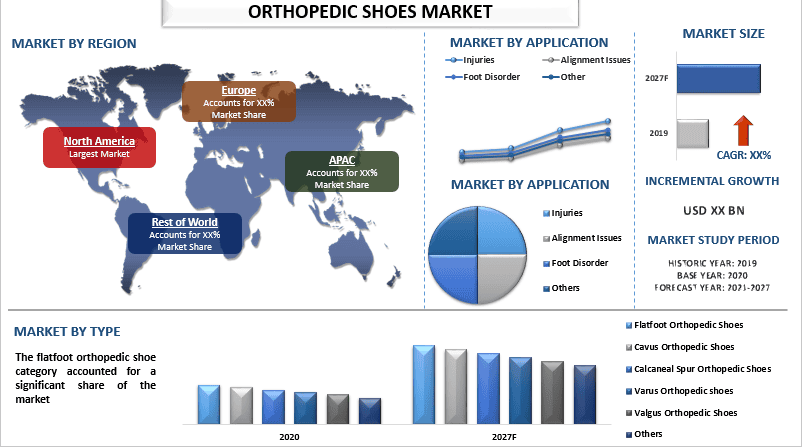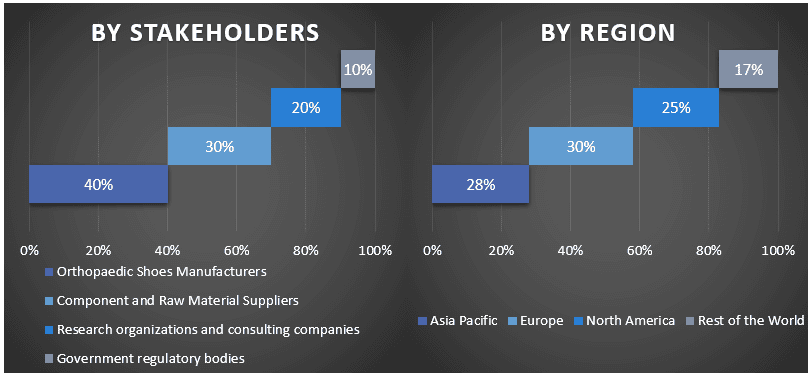- Inicio
- Acerca de nosotros
- Industria
- Servicios
- Leyendo
- Contáctenos
Mercado de calzado ortopédico: análisis actual y previsión (2021-2027)
Énfasis en el tipo (Zapatos ortopédicos para pie plano, Zapatos ortopédicos para pie cavo, Zapatos ortopédicos para espolón calcáneo, Zapatos ortopédicos para varo, Zapatos ortopédicos para valgo, Otros); Aplicación (Lesiones, Problemas de alineación, Trastornos del pie, Otros); Usuarios finales (Hombres, Mujeres); Canal de distribución (Tiendas físicas, Tiendas online); y Región/País

SOLICITAR MUESTRA GRATUITA EN PDF
Se espera que el mercado de calzado ortopédico registre una CAGR de alrededor del 5% durante el período 2021-2027. El calzado ortopédico está especialmente diseñado para personas con malformaciones en los pies y tobillos. Apoyan estos músculos, tendones y articulaciones corrigiendo su alineación de la manera correcta. Esto ayuda a reducir el dolor al caminar o estar de pie. Estos productos de calzado no solo brindan un mejor soporte, sino que también garantizan la salud general del pie al prevenir algunos problemas que pueden provocar dolor e incomodidad. Los zapatos ortopédicos tienen una variedad de características, como hebillas ajustables, correas de velcro y plantillas personalizadas para ayudar a aliviar problemas en los pies, como hallux valgus, callos y dedos en martillo. La creciente adopción de calzado ortopédico puede atribuirse a la creciente prevalencia de diversas enfermedades del pie, como punteras más anchas y plantillas para soporte del arco, junto con una población geriátrica en rápido crecimiento, lo que aumentará la demanda de terapias ortopédicas. Según las Naciones Unidas, la población de 60 años o más era de 962 millones en 2017, más del doble de lo que era en 1980, con 382 millones. Se espera que el número de ancianos se duplique nuevamente para 2050 y alcance casi los 2.100 millones en todo el mundo. Además, se prevé que el mercado de calzado ortopédico crezca debido a la creciente conciencia entre las personas en todo el mundo sobre las diferentes enfermedades ortopédicas y el aumento de los casos de osteoartritis. Por lo tanto, impulsando el mercado de calzado ortopédico a nivel mundial.
Dr. Comfort, Apex, New Balance, Vionic, Sole, Duna, Orthofeet, Piedro, Darco y Drew Shoe Inc. son algunos de los actores clave en el mercado. Estos actores han realizado varias fusiones y adquisiciones junto con asociaciones para facilitar a los clientes productos/tecnologías innovadores y de alta tecnología.
Perspectivas presentadas en el informe
“Entre los tipos, la categoría de calzado ortopédico para pie plano representó la mayor parte del mercado en 2020”
Según el tipo, el mercado se clasifica en calzado ortopédico para pie plano, calzado ortopédico cavo, calzado ortopédico para espolón calcáneo, calzado ortopédico varo y calzado ortopédico valgo. Entre los tipos, la categoría de calzado ortopédico para pie plano representó una parte importante del mercado debido a la creciente demanda de los atletas de calzado para pie plano, ya que brindan absorción de impactos, amortiguación y estabilidad en áreas de alto estrés, con el fin de mejorar las habilidades para caminar o correr. Además, los zapatos ortopédicos para pie plano tienen que ver con el soporte, y va más allá de los arcos. Al brindar un mejor soporte en todo el zapato, desde una mejor amortiguación debajo del talón hasta un mejor soporte del arco, los zapatos ortopédicos realmente pueden ayudar a realinear su pie.
"Entre las aplicaciones, se espera que el trastorno del pie sea testigo de la CAGR más alta durante el período de pronóstico"
Según la aplicación, el mercado se clasifica en lesiones, problemas de alineación, trastornos del pie y otros. Entre estos, se espera que el trastorno del pie sea testigo de la CAGR más alta durante el período de pronóstico. Esto se debe al aumento de la prevalencia de enfermedades del pie, accidentes, espolones óseos, pie roto, bursitis (inflamación de las articulaciones) y muchos más.
"Entre los usuarios finales, la categoría de mujeres representó la mayor parte del mercado en 2020"
Según los usuarios finales, el mercado se clasifica en hombres y mujeres. Entre los usos, la categoría de mujeres representó una parte importante del mercado porque las mujeres son más propensas a causar cualquier trastorno o deformidad en los pies, ya que tienen que usar sandalias incómodas durante mucho tiempo, lo que crea dolor, verrugas, uñas encarnadas y espolones óseos. Por ejemplo, según Osteoarthritis Action Alliance en 2021, el 62% de las personas con osteoartritis son mujeres.
"Entre los canales de distribución, la categoría de tiendas fuera de línea representó la mayor parte del mercado en 2020"
Según los canales de distribución, el mercado se clasifica en tiendas fuera de línea y tiendas en línea. Entre los canales de distribución, la categoría de tiendas fuera de línea representó una parte importante del mercado. Como muchas personas no pueden comprar sus zapatos en línea, las posibilidades de que el tamaño sea incorrecto, la incomodidad y la disponibilidad de duplicados son algunos de los factores que contribuyen al crecimiento de este segmento.
"América del Norte será testigo de un crecimiento significativo durante el período de pronóstico"
Para una mejor comprensión de la dinámica del mercado de calzado ortopédico, se realizó un análisis detallado de las diferentes regiones del mundo, incluidas América del Norte (EE. UU., Canadá y el resto de América del Norte), Europa (Alemania, Francia, España, Reino Unido, Italia y resto de Europa), Asia-Pacífico (China, India, Australia, Japón y resto de APAC), se ha llevado a cabo el resto del mundo. América del Norte constituye un mercado importante para la industria del mercado de calzado ortopédico en 2020 debido a la presencia de actores del mercado bien establecidos y la creciente prevalencia de enfermedades del pie en la región.
Razones para comprar este informe:
- El estudio incluye el tamaño del mercado y el análisis de pronóstico validados por expertos clave autenticados de la industria.
- El informe presenta una revisión rápida del desempeño general de la industria de un vistazo.
- El informe cubre un análisis en profundidad de los pares prominentes de la industria con un enfoque principal en las finanzas comerciales clave, la cartera de productos, las estrategias de expansión y los desarrollos recientes.
- Examen detallado de los impulsores, las restricciones, las tendencias clave y las oportunidades que prevalecen en la industria.
- El estudio cubre exhaustivamente el mercado en diferentes segmentos.
- Análisis regional profundo de la industria.
Opciones de personalización:
El mercado global de calzado ortopédico se puede personalizar aún más según los requisitos o cualquier otro segmento del mercado. Además de esto, UMI entiende que puede tener sus propias necesidades comerciales, por lo tanto, no dude en conectarse con nosotros para obtener un informe que se adapte completamente a sus requisitos.
Tabla de contenido
Metodología de investigación para el análisis del mercado mundial de calzado ortopédico (2021-2027)
El análisis del mercado histórico, la estimación del mercado actual y la previsión del mercado futuro del mercado mundial de calzado ortopédico fueron los tres pasos principales que se llevaron a cabo para crear y analizar la adopción de calzado ortopédico en las principales regiones del mundo. Se llevó a cabo una exhaustiva investigación secundaria para recopilar las cifras históricas del mercado y estimar el tamaño actual del mercado. En segundo lugar, para validar estas conclusiones, se tuvieron en cuenta numerosos hallazgos y supuestos. Además, se realizaron exhaustivas entrevistas primarias con expertos de la industria en toda la cadena de valor del mercado mundial de calzado ortopédico. Tras la asunción y validación de las cifras del mercado a través de entrevistas primarias, empleamos un enfoque de arriba abajo/de abajo arriba para pronosticar el tamaño completo del mercado. Posteriormente, se adoptaron métodos de desglose del mercado y triangulación de datos para estimar y analizar el tamaño del mercado de los segmentos y subsegmentos a los que pertenece la industria. La metodología detallada se explica a continuación:
Buscar más detalles sobre la metodología de investigación
Análisis del tamaño histórico del mercado
Paso 1: Estudio en profundidad de fuentes secundarias:
Se llevó a cabo un estudio secundario detallado para obtener el tamaño histórico del mercado de calzado ortopédico a través de fuentes internas de la empresa, como informes anuales y estados financieros, presentaciones de resultados, comunicados de prensa, etc., y fuentes externas, incluyendo revistas, noticias y artículos, publicaciones gubernamentales, publicaciones de la competencia, informes del sector, bases de datos de terceros y otras publicaciones creíbles.
Paso 2: Segmentación del mercado:
Después de obtener el tamaño histórico del mercado de calzado ortopédico, realizamos un análisis secundario detallado para recopilar información histórica del mercado y compartirla para diferentes segmentos y subsegmentos para las principales regiones. Los principales segmentos incluidos en el informe son el tipo, la aplicación, los usuarios finales y el canal de distribución. Además, se llevaron a cabo análisis a nivel de país para evaluar la adopción general de los modelos de prueba en esa región.
Paso 3: Análisis de factores:
Después de adquirir el tamaño histórico del mercado de diferentes segmentos y subsegmentos, realizamos un análisis de factores detallado para estimar el tamaño actual del mercado de calzado ortopédico. Además, realizamos un análisis de factores utilizando variables dependientes e independientes, como los distintos tipos, aplicaciones, usuarios finales y canales de distribución de la patología digital. Se llevó a cabo un análisis exhaustivo de los escenarios de demanda y oferta teniendo en cuenta las principales asociaciones, fusiones y adquisiciones, la expansión empresarial y los lanzamientos de productos en el sector del mercado de calzado ortopédico en todo el mundo.
Estimación y previsión del tamaño actual del mercado
Tamaño actual del mercado: Basándonos en la información práctica de los 3 pasos anteriores, llegamos al tamaño actual del mercado, los principales actores del mercado mundial de calzado ortopédico y las cuotas de mercado de los segmentos. Todas las cuotas porcentuales divididas y los desgloses del mercado necesarios se determinaron utilizando el enfoque secundario mencionado anteriormente y se verificaron a través de entrevistas primarias.
Estimación y previsión: Para la estimación y previsión del mercado, se asignaron ponderaciones a diferentes factores, incluyendo los impulsores y las tendencias, las restricciones y las oportunidades disponibles para las partes interesadas. Después de analizar estos factores, se aplicaron las técnicas de previsión pertinentes, es decir, el enfoque de arriba abajo/de abajo arriba, para llegar a la previsión del mercado hasta 2027 para los diferentes segmentos y subsegmentos en los principales mercados a nivel mundial. La metodología de investigación adoptada para estimar el tamaño del mercado abarca:
- El tamaño del mercado de la industria, en términos de ingresos (USD) y la tasa de adopción del mercado de calzado ortopédico en los principales mercados a nivel nacional
- Todas las cuotas porcentuales, divisiones y desgloses de los segmentos y subsegmentos del mercado
- Principales actores del mercado mundial de calzado ortopédico en términos de soluciones ofrecidas. Además, las estrategias de crecimiento adoptadas por estos actores para competir en el mercado de rápido crecimiento
Validación del tamaño y la cuota de mercado
Investigación primaria: Se realizaron entrevistas en profundidad con los líderes de opinión clave (KOL), incluyendo a los ejecutivos de alto nivel (CXO/VP, jefe de ventas, jefe de marketing, jefe de operaciones y jefe regional, jefe de país, etc.) en las principales regiones. Los resultados de la investigación primaria se resumieron y se realizó un análisis estadístico para demostrar la hipótesis establecida. Los aportes de la investigación primaria se consolidaron con los resultados secundarios, convirtiendo así la información en información práctica.
División de los participantes primarios en diferentes regiones

Ingeniería de mercado
Se empleó la técnica de triangulación de datos para completar la estimación general del mercado y para llegar a cifras estadísticas precisas de cada segmento y subsegmento del mercado mundial de calzado ortopédico. Los datos se dividieron en varios segmentos y subsegmentos después de estudiar varios parámetros y tendencias en las áreas de tipo, aplicación, usuarios finales y canal de distribución en el mercado mundial de calzado ortopédico.
El objetivo principal del estudio del mercado mundial de calzado ortopédico
Las tendencias actuales y futuras del mercado mundial de calzado ortopédico se señalaron en el estudio. Los inversores pueden obtener información estratégica para basar su criterio para las inversiones a partir del análisis cualitativo y cuantitativo realizado en el estudio. Las tendencias actuales y futuras del mercado determinaron el atractivo general del mercado a nivel regional, proporcionando una plataforma para que el participante industrial explote el mercado sin explotar para beneficiarse como una ventaja de ser el primero en actuar. Otros objetivos cuantitativos de los estudios incluyen:
- Analizar el tamaño actual y previsto del mercado de calzado ortopédico en términos de valor (USD). Además, analizar el tamaño actual y previsto del mercado de los diferentes segmentos y subsegmentos
- Los segmentos del estudio incluyen áreas de tipo, aplicación, usuarios finales y canal de distribución.
- Definir y analizar el marco regulatorio para la industria del mercado de calzado ortopédico.
- Analizar la cadena de valor involucrada con la presencia de varios intermediarios, junto con el análisis de los comportamientos de los clientes y la competencia de la industria.
- Analizar el tamaño actual y previsto del mercado de calzado ortopédico para la región principal.
- Los principales países de las regiones estudiadas en el informe incluyen Asia Pacífico, Europa, Norteamérica y el resto del mundo.
- Perfiles de las empresas del mercado de calzado ortopédico y las estrategias de crecimiento adoptadas por los actores del mercado para mantenerse en el mercado de rápido crecimiento
- Análisis regional en profundidad de la industria
Relacionados Informes
Los clientes que compraron este artículo también compraron










